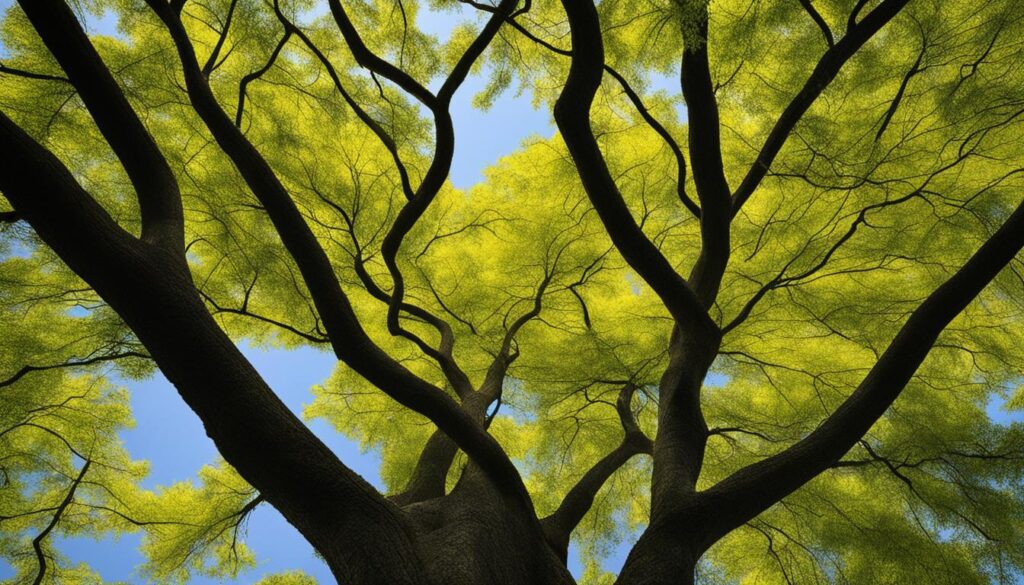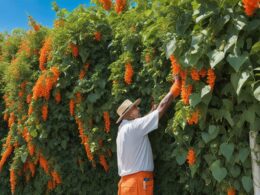If you’ve ever come across a tree with thorns on its trunk, chances are you’ve encountered the honey locust, scientifically known as Gleditsia. This impressive tree belongs to the pea family and boasts unique features that make it stand out among others in its category.
One of the distinguishing characteristics of the honey locust is its compound leaves. These leaves are deciduous, meaning they shed annually, offering a mesmerizing display of colors through the seasons. But what truly sets the honey locust apart is its stout thorns that adorn the trunk and branches, acting as a defense mechanism against potential threats.
The honey locust tree also produces unisexual flowers, typically greenish in color, and legume fruits with sweet-tasting flesh. Its versatility as an ornamental plant is well-known, adding both beauty and texture to gardens and parklands. Beyond aesthetics, the honey locust serves practical purposes as well, such as providing timber for construction and acting as animal fodder.
Join us as we delve deeper into the captivating world of trees with thorns on their trunks, shining a spotlight on the remarkable honey locust and all its fascinating characteristics.
Characteristics and Habitat of Honey Locust
The honey locust, also known as thorny locust or thorn tree, is a medium-sized tree with pleasing, graceful foliage. It is a member of the Fabaceae family and belongs to the genus Gleditsia. The honey locust is recognized for its compound leaves, which consist of smaller leaflets that measure 3/4 to 1 1/2 inches long.
This versatile tree is commonly found in various habitats, including bottomland woods, old pastures, and sandy prairies. It has the remarkable ability to adapt to different types of soil, making it suitable for a wide range of landscapes. The honey locust’s fast growth rate ensures that it can quickly establish itself in its environment.
One notable feature of the honey locust is the presence of thorns on its trunk and branches. These thorns serve as a defense mechanism, deterring browsing animals and protecting the tree from potential harm.
- Graceful Foliage: The honey locust tree boasts elegant and attractive foliage, adding beauty to any landscape.
- Adaptable to Most Soils: Regardless of soil composition, the honey locust can thrive and flourish, making it a suitable choice for various gardening projects.
- Medium-Sized Tree: With its moderate height and width, the honey locust is ideal for homeowners looking for a tree that provides shade and aesthetic appeal.
- Well-Suited for Different Habitats: From bottomland woods to old pastures and sandy prairies, the honey locust is adaptable to a wide range of environments.
Overall, the honey locust is a resilient tree known for its stunning foliage, ability to adapt, and rapid growth rate. Whether planted in residential landscapes or natural habitats, the honey locust adds a touch of grace and beauty while enhancing the ecosystem around it.
Uses and Maintenance of Honey Locust
When it comes to versatile and adaptable native trees, honey locust is a standout choice. Growing up to 70-80 feet in height and with a width ranging from 20-40 feet, honey locust trees provide a striking presence in any landscape. Their open foliage, combined with their tolerance to heat, humidity, and heavy soils, make them ideal for urban environments.
Honey locust trees offer more than just aesthetic appeal. They produce seeds every year or two, ensuring the continuity of their natural growth cycle. With a fairly fast growth rate, honey locust trees can establish themselves quickly and thrive in various soil conditions.
In addition to their beauty and adaptability, honey locust trees have practical applications. The wood of honey locust trees is reddish, strong, coarse-textured, and moderately durable, making it suitable for fence posts, furniture, and even fuel wood. This versatility makes honey locust a popular choice among homeowners, farmers, and landscapers.
However, it’s important to note that honey locust trees can be susceptible to diseases and pests. Common concerns include powdery mildew, canker, honeylocust plant bugs, and mimosa webworms. Regular maintenance and proper management are crucial in preventing and addressing these issues to ensure the long-term health and longevity of your honey locust trees.
What Causes Trees to Develop Thorns on Their Trunks?
Some trees develop thorns on their trunks as a result of natural defense mechanisms. Understanding tree trunk knots as a response to stress or environmental factors can help in identifying the reasons behind the formation of these thorns. Certain species also develop thorns as a way to protect themselves from animals.
Can Termite Infestation Cause Thorn growth on Trees?
Yes, termite infestation can cause thorn growth on trees. When termites burrow into the tree, it can disrupt the tree’s growth patterns, leading to abnormal formations such as thorns. In severe cases, the termite holes in tree may disrupt the tree’s nutrient and water transport systems, leading to further issues.









